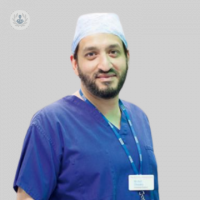Oesophageal cancer surgery
What is oesophageal cancer surgery?
Oesophageal cancer is a form of cancer that affects the oesophagus which is the tube that takes food from the throat to the stomach. Cancer of the oesophagus occurs when cancer cells develop, starting in the inner layer of the oesophagus, and can spread into the other layers, and to other parts of the body. Surgery aims to remove the part of the oesophagus affected by the cancerous cells.
Why is oesophageal cancer surgery performed?
Surgery for this type of cancer will be recommended for patients in stages one to three of oesophageal cancer. Those with stage four oesophageal cancer would not benefit from surgery as it is extremely unlikely to be effective. Often surgery will be combined in a treatment plan with other measures such as chemotherapy and sometimes radiotherapy which are usually given prior to surgery.
What does it involve?
There are three types of oesophageal cancer surgery. The first is called oesophagectomy and involves surgically removing the part of the oesophagus containing the tumour. Sometimes a part of the stomach is also removed, and some of the lymph nodes located close to the oesophagus as these may also contain cancerous cells. This measure increases chances of the cancer not returning. This surgery is done for earlier stages of oesophageal cancer.
If oesophageal cancer is detected very early on, then the cancerous cells can be removed using endoscopic mucosal resection (EMR). This involves removing the tumour with a wire loop at the end of an endoscope, which is a narrow, flexible tube. This tube is passed through the throat, meaning there are no incisions made on the skin.
For the later stages of oesophageal cancer, where swallowing can become difficult, it may become necessary for a stent to inserted into the oesophagus, which helps to hold it open, making swallowing easier.
How to prepare for it
Prior to surgery, the patient would be examined by their doctor to ensure they are well enough to undergo the operation. The surgeon will explain the procedure in detail, and exactly what to expect. The patient will have opportunities to ask any questions about the procedure.
The patient should not eat or drink a few hours prior to surgery, and they may need to bathe and remove body hair from the area undergoing surgery. The patient may also be asked to wear a pair of compression stockings during and immediately after the operation to reduce the risk of blood clots forming in the leg.
Post-operative care
After surgery, the patient is likely to stay in the intensive care unit for a number of days. Here the patient will be given painkillers to manage the pain. There will also be a number of drips attached to the body, which must be kept for a few days. These keep the patient hydrated.
After surgery, the patient will begin by trying to drink very small sips of liquid. It is also common for the patient to have a temporary feeding tube inserted into the small bowel. This allows the patient to be fed until they can eat and drink normally. This can take up to six weeks. Some weight loss is to be expected after surgery as a result.





